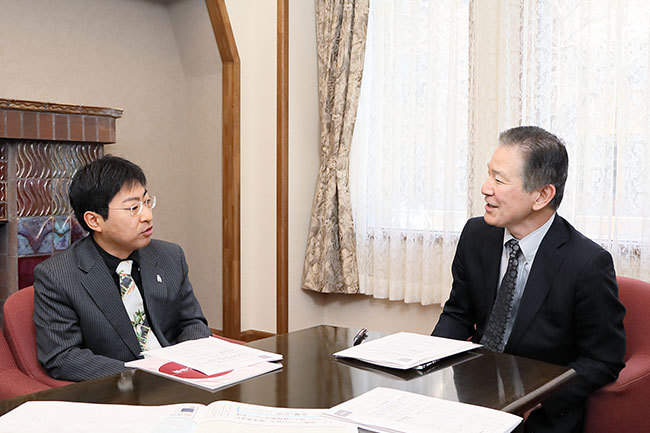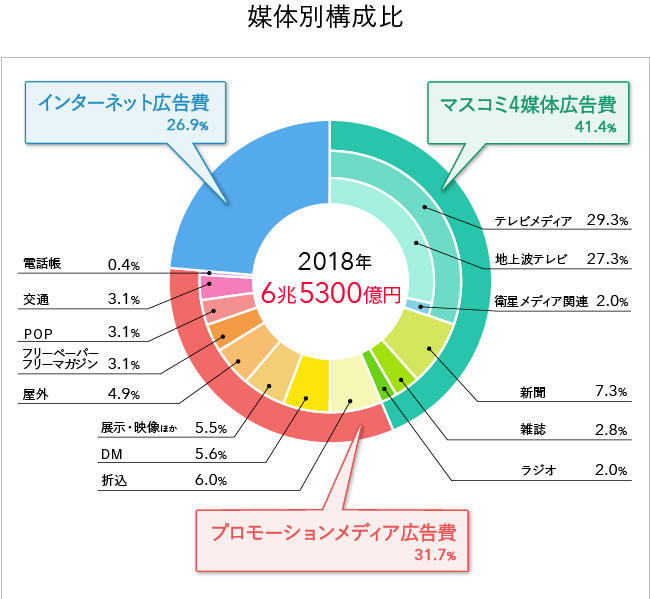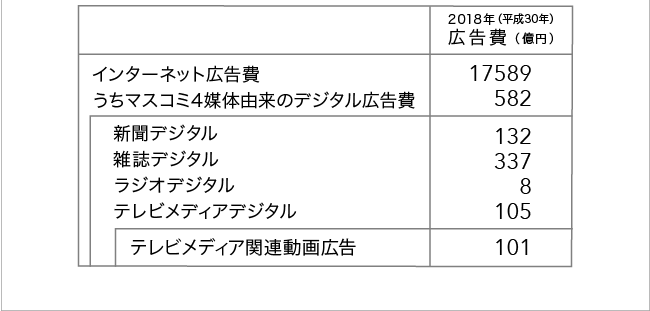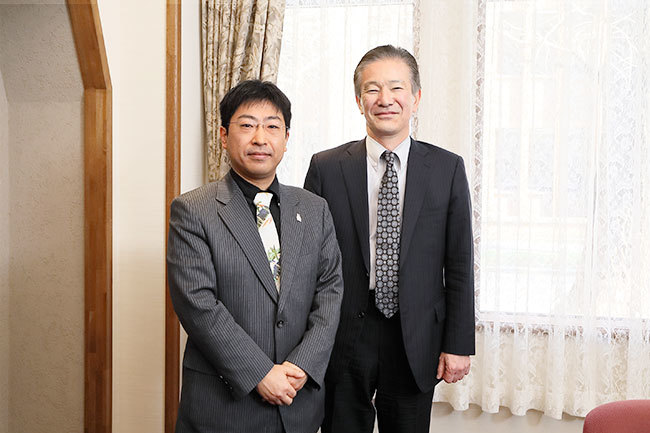" Japan's Advertising Expenditures in 2018 " exceeded the previous year's results for the seventh consecutive year, with internet advertising spending in particular driving overall growth with double-digit growth for the fifth consecutive year.
Mr. Ritsuya Oku of Dentsu Inc. Media Innovation Lab interviewed Professor Tsunekazu Shishido of the University of Tokyo Graduate School of Law and Politics, an expert in constitutional law with extensive media knowledge, about the digital shift in mass media, media credibility, and the renewed role expected of advertising.

Professor Tsunekazu Shishido (left), Graduate School of Law and Politics, University of Tokyo, and Ritsuya Oku, Dentsu Inc. Media Innovation Lab
The Expanding Digital Shift of the Four Major Media Outlets
Oku: Dentsu Inc. has again announced its estimated "Advertising Expenditures in Japan" for this year. Public interest likely centers on when internet advertising spending will surpass television advertising spending. The result shows television advertising spending narrowly remained higher. Additionally, starting this year, we have newly estimated "Digital Advertising Spending Originating from the Four Mass Media" within internet advertising spending.
Shishido: The digital shift of mass media is now an unavoidable global trend. Television stations and newspapers are at the stage of discussing how to innovate for this digital shift, from production and editing methods to staffing structures and management. In that sense, as a starting point, I find it extremely meaningful that you have provided the figures for digital advertising spending originating from the four mass media outlets.


Digital advertising spending originating from the four mass media outlets
Oku: Television, radio, newspapers, and magazines are all tackling digital in various ways, but it inevitably incurs costs, and as a business model, it's still very much in the trial-and-error phase.
For example, digital media originating from TV, like catch-up streaming, often sells ad slots separately from the TV broadcast itself. However, there's also the approach of not necessarily separating terrestrial broadcasts and digital media, but instead simultaneously streaming the same program and running the same commercials on both to ensure reach.
Shishido: While expanding the same content digitally as terrestrial broadcasts is one approach, the crucial challenge is how to create situations where mass media widely reaches, is viewed, and is read by everyone, especially younger generations. Radio achieved simultaneous terrestrial and digital broadcasting with the advent of radiko.jp. Newspapers must also consider how to get young people to read them on smartphones. Simultaneous broadcasting is likely one target form for television too.
Oku: Television media has very long dwell times. So, it would be good to have designs that connect current program content with past content online, or even designs where broadcasters collaborate. I believe we need an overall design that gets people to watch programs and ads, and then lets them swim through the space-time of related content.
Shishido: With newspapers, it's difficult to find an article from a week ago just because you thought, "This article was interesting, so I want to see related articles." But digitally, you can follow related articles one after another. Therefore, simultaneously streaming the latest articles or programs digitally is essentially the "entry point"; we should consider the navigability from there.
Oku: For TV-derived digital media, we have "simultaneous streaming," "catch-up within a week," and "archives of past broadcasts" for older content. Connecting these spatially should be possible. We could use hashtags or create networked structures between content.
Shishido: Regarding these simultaneous broadcasts and digital initiatives, I believe NHK has a significant role to play. Since NHK aims for continuous simultaneous streaming of TV programs within fiscal year 2019, I hope they can collaborate with commercial broadcasters starting from that point to shape the future of new media.
Expanding Internet Advertising Potential Through Viewing Data Utilization
Oku: In the coming era, advertising agencies face the challenge of visualizing advertising effectiveness. We need to consider new ways to measure value and sales approaches – whether it's traditional ratings or impression-based measurement like internet ads.
Currently, TV, radio, and internet each measure effectiveness separately, resulting in siloed data by medium that prevents a holistic overview. If digitalization enables us to identify the "overlap" – whether people exposed to programs or ads on one station share the same attributes as those on another – it will fundamentally change how advertising is delivered.
Shishido: I see potential in leveraging viewing data to organically link and develop TV commercials with TV-derived digital advertising.Viewing data consists of specific viewing history (so-called viewing logs), which is personal information, and non-specific viewing history, which is not personal information. Specific viewing history is data like "Person A watched the news," while non-specific viewing history is data like "The owner of this device watched the news." Regarding the utilization of this non-specific viewing history, the five major Tokyo-based commercial broadcasters conducted a joint technical proof-of-concept experiment to aggregate and analyze television viewing data.
If the siloed, shallow viewing data can be made slightly deeper through collaboration between stations, it becomes possible to visualize "overlaps," such as "Many people in their 20s watch this program on this station and that program on that station."
Oku: By collaborating, the five Tokyo-based commercial broadcasters can better visualize how much reach a particular program or advertisement has among specific demographics. It would be ideal to design systems where such viewer overlaps are discernible to the media side. However, we must also thoroughly discuss approaches that ensure viewers properly understand and give their consent.
The Trustworthiness of Media as a Social Entity
Oku: This year marks the first time "programmatic advertising spending" has exceeded 1 trillion yen within total internet advertising expenditure.
Shishido: It's shocking that one-sixth of Japan's total advertising expenditure now goes to internet programmatic advertising. Programmatic advertising targets individuals at a very micro level, rather than mass audiences or communities. Since it now accounts for one-sixth of all advertising, the traditional broad image associated with "advertising" has likely changed significantly.
Oku: In the sense that it's the heyday of targeted advertising, perhaps it's no longer "advertising" but "narrowcasting." Internet advertising has driven the growth of advertising spending over the past few years. Unlike existing media, online media has no licensing system, no bandwidth restrictions, and the number of service providers keeps increasing.
Shishido: I believe the existence of various ad formats, including performance-based ads, is essential in an era of diversifying values and awareness. However, performance-based ads specialize in sales functions, focusing their power on driving people to purchase. On the other hand, I think the function of advertising to cultivate social trust in companies and brands will become increasingly important.Mass advertising will retain its sales function, but other functions will emerge with sharper contours. For example, branding.
Traditional mass media carries inherent trust. Historically, advertising in these outlets has helped establish a shared societal perception that a brand is credible.While you can't truly know a product's quality until you use it, the perception that "if that company is making it, it should be fine" relies heavily on the brand's "social credibility as an entity." The fact that "not just me, but most other people also generally trust it" is also crucial. In that sense, no matter how powerful programmatic advertising becomes, if existing mass media isn't maintained to a certain extent, society as a whole will suffer, won't it?
It's time to reconsider the public nature of advertising.
Oku: The element of cultivating social trust through advertising is difficult to quantify and doesn't directly connect to PDCA cycles, so it tends to be overlooked. The world of internet advertising has, in a sense, developed performance-based advertising—which makes results easier to visualize—without focusing on that aspect. This has led to issues like brand damage, ad fraud, and viewability problems within internet advertising.Even in the digital realm, there's a movement to re-evaluate the relationship between brands and advertising, as seen in the growing attention on brand lift achieved through video ads.
Shishido: Regarding issues like ad fraud, digital media platforms have recently been actively implementing countermeasures, haven't they? I think this reflects a growing awareness of problems related to the "public nature" of internet advertising.
Beyond advertising, if fake news and disinformation spread widely through online media, it heightens concerns that societal problems won't be resolved effectively and society could become divided in undesirable ways. Both advertisers and media are now expected to proactively provide information that helps build trustworthy media and brands, and delivers insights that enable consumers to make wise choices.In this context, rather than simply regulating online media or internet advertising, positive initiatives are essential. For this, it will be crucial for mass media and online media to engage in mutual discussion and explore better forms of collaboration. Both advertisers and advertising agencies should be mindful of supporting and expanding the media functions and journalistic functions inherent to traditional media.
Oku: The relationship between mass media and digital-native online media has gradually shifted. It's moving beyond mere competition toward mutual support. From the perspective of the public's "right to know," efforts to enhance mutual credibility between mass media and online media are necessary.Mass media possesses the journalistic function of actively gathering information on the ground, while online media offers unprecedented reach mechanisms through human-mediated networks. How to design a comprehensive strategy encompassing both is a theme the advertising industry must also consider.
Alongside these efforts by advertisers and media outlets, there's also the challenge of cultivating media literacy among younger generations.
Shishido: When it comes to children and adolescents accessing information, the tendency is often to simply regulate by saying, "Don't let children see this." Conversely, I would like to see an approach where we actively encourage them to see certain things, fostering individual lifestyles and personalities through advertising. Since we have the technology for targeted advertising, couldn't it be used for more than just selling products?
Advertising faces various criticisms, but currently, whether consumers buy a product or not still relies on them first receiving the ad, making some judgment, and then deciding to purchase. However, with the Fourth Industrial Revolution being promoted by the government, all home appliances may become IoT-enabled. We might see the arrival of a "Society 5.0" where, for example, juice automatically gets delivered when the refrigerator runs low.If "human judgment" is no longer necessary, advertising could, in a sense, cease to exist.
But such a society wouldn't feel human. That's why I believe advertising's role will undergo a significant transformation. It won't just be about selling products; it will increasingly focus on engaging human consciousness and reason, encouraging autonomous judgment, and cultivating smarter consumers. This role of advertising will become ever more crucial.
Oku: A key concern of our era is that people only see what they want to see. They consume only one type of information or opinion and assume that represents the whole world. This applies to advertising too—people only see what they like. The internet accelerates this tendency, yet it also opens doors to worlds we wouldn't otherwise know.
Shishido: I hope it's the latter. We must build a society that avoids deepening divisions.
Oku: We should probably think a bit more broadly than the traditional mission given to advertising. To motivate the advertising industry and advertisers toward this, we might need new metrics aimed broadly at society, beyond just ratings, clicks, and visit rates.
Shishido: Companies, too, should have a vision beyond just business—a vision of the consumers they seek and the kind of society they want to create. While some in traditional media inevitably view technological and social change with skepticism, I want everyone to see every change as a new opportunity for us all to live better lives.
Oku: We want people to embrace the digital shift positively. I also believe traditional media still has significant room to fully leverage the internet. Thank you for today.












